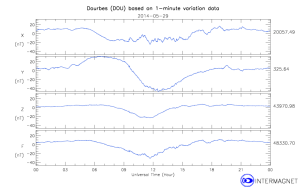- The largest natural time-dependent magnetic anomalies are produced by magnetic storms produced themselves by variations of the solar wind. A magnetic storm is a perturbation of the Earth’s magnetic field, caused by solar disturbances, usually lasting for a brief period (several days) and characterized by large deviations from the usual value of at least one component of the field. They can be predicted at FIXED meteorological stations by measuring the trends of the absolute values of the earth magnetic field. The Dst is a geomagnetic index which monitors the world wide magnetic storm level. It is constructed by averaging the horizontal component of the geomagnetic field from mid-latitude and equatorial magnetograms measured by meteorological stations from all over the world. Negative Dst values indicate a magnetic storm is in progress, the more negative Dst is the more intense the magnetic storm.One of the main practical application of these measurements is the prediction of near future radio-communication problems as magnetic storms disturb the ionosphere, but some powerful magnetic storms have also disturbed the electrical power grid in some countries.
Outside of magnetic storms, there are other natural time-dependent slight and slow variations of the magnetic field, they are called ‘diurnal’ variations while smaller and quicker variations are called ‘micro’ variations. That’s the reason why the measurement of the space-dependent TOTAL magnetic field (or one of its vertical or horizontal vector) is not sufficient to make actual field surveys
This is a very good introduction of all these concepts: geomag
This is a source of real magnetogram samples: Intermagnet
This is the plots you can get from there from any Intermagnet Observatory in the world. These are from the DOURBES node in Belgium.
- Natural space-dependent magnetic anomalies are caused by the juxtaposition of soils and stones with highly contrasting magnetic properties produced by earlier volcanic activities. These characteristic features are detected by geologists to find specific underground or underwater minerals or metals (even gold since gold deposits are usually accompanied with “black sand”-magnetite deposits) or, in petrology to locate gas or oil pockets kept within porous stones.
- Artificial (man-made)magnetic anomalies are generated by:
o Buried or sunken objects containing a large proportion of ferromagnetic metal (iron or steel)
o Soil disturbances like filling holes with a soil of different magnetic characteristics than the local ground or unfilled holes like tombs or wells.
o Burned features like fire pits, baked clay objects, ashes…
o Permanent magnets buried specially to be easily located later on by geologists or archaeologists.
Thus, magnetometers are useful to:
o Public Works to locate pipelines or the steel bars of concrete foundations
o Geologists to locate coal, water, minerals, gold, oil and gas
o Environmentalists to find buried barrels of dangerous or polluted products
o Archaeological Research to locate :
- old wall foundations,
- refilled wells
- tombs
- old paths
- Pits
- Hearths
- kilns & furnaces
- Cooking sites
- Midden deposits
- Ditched enclosures
- Trackway
o Military and Humanitarian deminers to locate and destroy UXO (bombs, mines, grenades)
o Sunken Ship Seekers to find cannons, anchors which help to locate the ship remains themselves
o Treasure Hunters looking for iron-made containers (box or case) of precious material
o Relic Hunters looking for old man-made iron objects
In summary, magnetometers are able to detect the presence of Ferro-Magnetic material (Iron, Steel, Cobalt, Nickel,…) or Ferri-material (i.e. containing Magnetite,…) because they disturb the value and direction of the earth magnetic field.
However, magnetometers are COMPLETELY insensible to any other metals, they can not be used as metal detectors even if they are sometimes used as complements in the research of targets.
Magnetometers also can not easily detect deeply buried (or sunken) small objects except with a highly sophisticated instrument. Look at the figure 46, page 43 of the ampm-opt.pdf document, it shows that 1 pound of pure iron (not exactly a small object, equivalent to an ordinary hammer head) could be detected at 3 meters BUT would only generate a field gradient of 1nT.
The same pound of iron generates a gradient of 10nT at 1.5m.
If you only own a mag with a sensitivity of 10 to 25nT (typical of fluxgate and differential mags), then the same mass of iron could only be detected at 1 meter or less IF and only IF your line of survey passes right above it. It is useful to remember that the field produced by a given magnetic moment falls off as the inverse cube of the distance, not the inverse square.
Note that the field produced by eddy currents induced by Metal detectors (VLF or PI) falls off as the inverse fourth power of the distance (also the case of gradiometers). It is the reason why a mag is able to detect deeper targets than metal detectors (provided they are magnetic).

